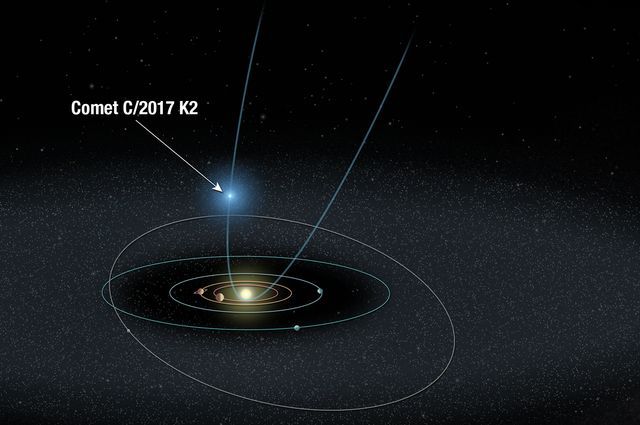
A 12-mile-wide primitive comet has been spotted entering the solar system and hurtling towards the sun.
The comet, named K2, is currently 1.5 billion miles from the sun, making it the most distant comet ever discovered to be moving towards Earth.
Astronomers believe K2 came from the Oort Cloud, the giant shell of icy objects that surrounds the solar system. It was photographed by NASA's Hubble Telescope earlier this year just beyond Saturn's orbit, having travelled for millions of years from beyond the solar system.
Researchers led by David Jewitt, from UCLA, published their study of the comet in The Astrophysical Journal. The team spotted the comet after it developed an 80,000-mile-wide cloud of dust known as a coma. This giant cloud surrounds the 12-mile-wide comet nucleus.
K2 is expected to make its closest approach to the sun in 2022 when it will pass just beyond the orbit of Mars—a distance of over 142 million miles.
Unlike most comets, K2's coma appears to be the result of the sun's heat defrosting some of the volatile gasses that are found on the surface of the K2. "Because K2 is so far from the sun and so cold, water ice there is frozen like a rock, and we know for sure that the activity—all of the fuzzy stuff making it look like a comet—is not produced by the evaporation of water ice, as it is in other comets," Jewitt said in a statement.
Instead, these volatile gasses, like oxygen, nitrogen and carbon dioxide, are lifted off the surface as the rock heats up and release the coma dust. "The volatiles on the surface are the ones that absorb the heat from the sun, so, in a sense, the comet is shedding its outer skin," he added.
Normally comets are only discovered when they are much closer to Earth, meaning all this outer layer has already been shed. "That's why I think K2 is the most primitive comet we've seen," Jewitt said.
Researchers believe K2 is missing its "tail" because at the moment, the particles are too large for them to be swept back into this formation. However, as it gets closer to the sun, K2 should get more and more active, and a tail will develop.
Concluding, the team wrote: "The early detection of K2 will allow a much richer investigation of the behavior of a long-period comet entering the planetary region, leading to an improved understanding of the processes occurring when warming up from Oort Cloud temperatures."
Uncommon Knowledge
Newsweek is committed to challenging conventional wisdom and finding connections in the search for common ground.
Newsweek is committed to challenging conventional wisdom and finding connections in the search for common ground.
About the writer
Hannah Osborne is Nesweek's Science Editor, based in London, UK. Hannah joined Newsweek in 2017 from IBTimes UK. She is ... Read more





